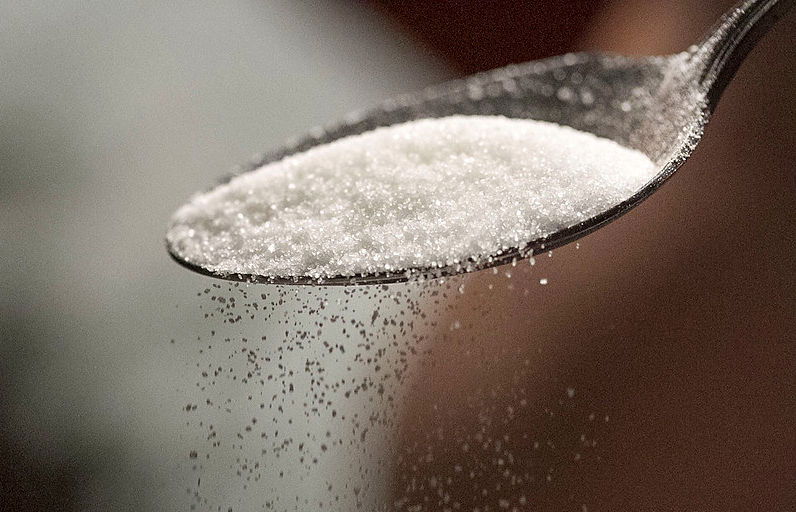OARSI. Is Osteoarthritis a Serious Disease? (Osteoarthritis Research Society International, 2020) https://oarsi.org/research/infographic-oa-serious-disease (Accessed 1 Dec 2021).
Sellam, J. & Berenbaum, F. Is osteoarthritis a metabolic disease?. Joint Bone Spine 80, 568–573 (2013).
Ding, C. et al. Serum levels of vitamin D, sunlight exposure, and knee cartilage loss in older adults: The Tasmanian older adult cohort study. Arthritis Rheum. 60, 1381–1389 (2009).
Felson, D. T. et al. Low levels of vitamin D and worsening of knee osteoarthritis: Results of two longitudinal studies. Arthritis Rheum. 56, 129–136 (2007).
Konstari, S. et al. Association of 25-hydroxyvitamin D with the incidence of knee and hip osteoarthritis: A 22-year follow-up study. Scand. J. Rheumatol. 41, 124–131 (2012).
McAlindon, T. E. et al. Relation of dietary intake and serum levels of vitamin D to progression of osteoarthritis of the knee among participants in the Framingham Study. Ann. Intern. Med. 125, 353–359 (1996).
Arden, N. K. et al. The effect of vitamin D supplementation on knee osteoarthritis, the VIDEO study: A randomised controlled trial. Osteoarthr. Cartil. 24, 1858–1866 (2016).
Jin, X. et al. Effect of vitamin D supplementation on tibial cartilage volume and knee pain among patients with symptomatic knee osteoarthritis: A randomized clinical trial. J. Am. Med. Assoc. 315, 1005–1013 (2016).
McAlindon, T. et al. Effect of vitamin D supplementation on progression of knee pain and cartilage volume loss in patients with symptomatic osteoarthritis: A randomized controlled trial. J. Am. Med. Assoc. 309, 155–162 (2013).
Nevitt, M. C. et al. Very low prevalence of hip osteoarthritis among Chinese elderly in Beijing, China, compared with whites in the United States: The Beijing osteoarthritis study. Arthritis Rheum. 46, 1773–1779 (2002).
Zhang, Y. et al. Comparison of the prevalence of knee osteoarthritis between the elderly Chinese population in Beijing and whites in the United States: The Beijing Osteoarthritis Study. Arthritis Rheum. 44, 2065–2071 (2001).
Valdes, A. M. et al. Sex and ethnic differences in the association of ASPN, CALM1, COL2A1, COMP, and FRZB with genetic susceptibility to osteoarthritis of the knee. Arthritis Rheum. 56, 137–146 (2007).
Zhu, Z.-H. et al. Associations between vitamin D receptor gene polymorphisms and osteoarthritis: An updated meta-analysis. Rheumatology 53, 998–1008 (2014).
Glover, T. et al. race, and experimental pain sensitivity in older adults with knee osteoarthritis. Arthritis Rheum. 64, 3926–3935 (2012).
Sanghi, D. et al. Does vitamin D improve osteoarthritis of the knee: A randomized controlled pilot trial. Clin. Orthop. Relat. Res. 471, 3556–3562 (2013).
Zheng, S. et al. Maintaining vitamin D sufficiency is associated with improved structural and symptomatic outcomes in knee osteoarthritis. Am. J. Med. 130, 1211–1218 (2017).
Um, J., Zaidi, A. & Choi, S. J. Active Ageing Index in Korea–comparison with China and EU countries. Asian Soc. Work Policy Rev. 13, 87–99 (2019).
Yoo, K., Cho, J. & Ly, S. Vitamin D intake and serum 25-hydroxyvitamin D levels in Korean adults: Analysis of the 2009 Korea National Health and Nutrition Examination Survey (KNHANES IV-3) using a newly established vitamin D database. Nutrients 8, 610 (2016).
Chen, D. et al. 1, 25-Dihydroxyvitamin D3 activates MMP13 gene expression in chondrocytes through p38 MARK pathway. Int. J. Biol. Sci. 9, 649 (2013).
Hdud, I. M. & Loughna, P. T. Influence of 1α, 25-dihydroxyvitamin D 3 [1,25(OH)2D3] on the expression of Sox 9 and the transient receptor potential vanilloid 5/6 ion channels in equine articular chondrocytes. J. Anim. Sci. Technol. 56, 33 (2014).
Slominski, A. T. et al. In vivo evidence for a novel pathway of vitamin D3 metabolism initiated by P450scc and modified by CYP27B1. FASEB J. 26, 3901–3915 (2012).
Slominski, A. T. et al. Detection of novel CYP11A1-derived secosteroids in the human epidermis and serum and pig adrenal gland. Sci. Rep. 5, 1–12 (2015).
Slominski, A. T. et al. Characterization of a new pathway that activates lumisterol in vivo to biologically active hydroxylumisterols. Sci. Rep. 7, 11434 (2017).
Slominski, A. T. et al. Novel activities of CYP11A1 and their potential physiological significance. J. Steroid Biochem. Mol. Biol. 151, 25–37 (2015).
Spector, T. D. & MacGregor, A. J. Risk factors for osteoarthritis: Genetics. Osteoarthr. Cartil. 12, 39–44 (2004).
Cui, A. et al. Global, regional prevalence, incidence and risk factors of knee osteoarthritis in population-based studies. EClinicalMedicine 29, 100587 (2020).
Van Schoor, N. & Lips, P. Global overview of vitamin D status. Endocrinol. Metab. Clin. 46, 845–870 (2017).
Srikanth, V. K. et al. A meta-analysis of sex differences prevalence, incidence and severity of osteoarthritis. Osteoarthr. Cartil. 13, 769–781 (2005).
Sniekers, Y., Weinans, H., Bierma-Zeinstra, S., Van Leeuwen, J. & Van Osch, G. Animal models for osteoarthritis: The effect of ovariectomy and estrogen treatment—A systematic approach. Osteoarthr. Cartil. 16, 533–541 (2008).
Campbell, C. M. & Edwards, R. R. Ethnic differences in pain and pain management. Pain Manag. 2, 219–230 (2012).
Parsons, C. et al. How well do radiographic, clinical and self-reported diagnoses of knee osteoarthritis agree? Findings from the Hertfordshire cohort study. Springerplus 4, 177 (2015).
Hailu, A., Knutsen, S. & Fraser, G. Associations between meat consumption and the prevalence of degenerative arthritis and soft tissue disorders in the adventist health study, California USA. J. Nutr. Health Aging 10, 7 (2006).
Choi, W.-S. et al. The CH25H–CYP7B1–RORα axis of cholesterol metabolism regulates osteoarthritis. Nature 566, 254–258 (2019).
Dunlop, E. et al. Vitamin D composition of Australian foods. Food Chem. 358, 129836 (2021).
Cashman, K. D., O’Sullivan, S. M., Galvin, K. & Ryan, M. Contribution of vitamin D2 and D3 and their respective 25-hydroxy metabolites to the total vitamin D content of beef and lamb. Curr. Dev. Nutr. 4, nzaa112 (2020).
Crowe, F. L. et al. Plasma concentrations of 25-hydroxyvitamin D in meat eaters, fish eaters, vegetarians and vegans: Results from the EPIC–Oxford study. Public Health Nutr. 14, 340–346 (2011).
Kim, K. W., Park, H. A., Cho, Y. G. & Bong, A. R. Protein intake by Korean adults through meals. Korean J. Health Promot. 21, 63–72 (2021).
Shea, M. K. et al. Association of Vitamin K status combined with Vitamin D status and lower-extremity function: A prospective analysis of two knee osteoarthritis cohorts. Arthritis Care Res. 70, 1150–1159 (2018).
Kim, E.-S., Kim, M.-S., Na, W.-R. & Sohn, C.-M. Estimation of vitamin K intake in Koreans and determination of the primary vitamin K-containing food sources based on the fifth Korean National Health and Nutrition Examination Survey (2010–2011). Nurs. Res. Pract. 7, 503–509 (2013).
The Korea National Health and Nutrition Examination Survey (KNHANES) [Internet]. Korea, Chungcheongbuk-do, Cheongju (28159): Korea Disease Control and Prevention Agency. https://knhanes.kdca.go.kr/knhanes/sub03/sub03_02_05.do (Accessed 29 Nov 2021).
KCDC. Korea National Health and Nutrition Examination Survey VI, the first year (2013): Professional Surveyor Education and Quality Control for Osteoarthritis Examination. Korea, Chungcheongbuk-do, Cheongju (28159): Korea Centers for Disease Control and Prevention (2013).
Yoshimura, N. et al. Prevalence of knee osteoarthritis, lumbar spondylosis, and osteoporosis in Japanese men and women: The research on osteoarthritis/osteoporosis against disability study. J. Bone Miner. Metab. 27, 620–628 (2009).
Kellgren, J. & Lawrence, J. Radiological assessment of osteo-arthrosis. Ann. Rheum. Dis. 16, 494 (1957).
Altman, R. et al. Development of criteria for the classification and reporting of osteoarthritis: Classification of osteoarthritis of the knee. Arthritis Rheum. 29, 1039–1049 (1986).
Altman, R. et al. The American College of Rheumatology criteria for the classification and reporting of osteoarthritis of the hip. Arthritis Rheum. 34, 505–514 (1991).
Dietary reference intakes for Koreans. (Ministry of Health & Welfare, The Korean Nutrition Society, 2015).
Dietary Reference Intakes for Calcium and Vitamin D. (The National Academies Press: IOM, Institute of Medicine); 2011.
KOSIS. Distribution of Income Index. Statistics Korea; 2008–2014. http://kosis.kr/statHtml/statHtml.do?orgId=101&tblId=DT_1L6E001 (Accessed 15 May 2020).
Seo, M. H. et al. The association between daily calcium intake and sarcopenia in older, non-obese Korean adults: The fourth Korea National Health and Nutrition Examination Survey (KNHANES IV) 2009. Endocr. J. 60, 679–686 (2013).
WHO. Global recommendations on physical activity for health. Sydney: Health Communications Australia (World Health Organization, 2010).
Choi, H. S. et al. Vitamin D insufficiency in Korea—a greater threat to younger generation: The Korea National Health and Nutrition Examination Survey (KNHANES) 2008. J. Clin. Endocrinol. Metab. 96, 643–651 (2011).
WHO. The Asia-Pacific perspective: redefining obesity and its treatment (2000).




